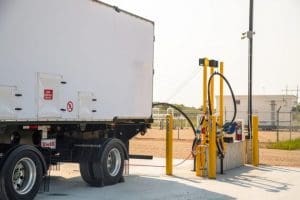This article was written by Sam Wade.
Massive waste streams are produced as the result of human activity, including activity associated with livestock, agricultural operations, and wastewater treatment. Additionally, one-third of food produced for human consumption — about 1.3 billion tons (1.18 billion tonnes) per year globally — is wasted. Current methods to dispose of all this organic waste generates multiple environmental problems, including the release of methane, a powerful greenhouse gas (GHG) that has a heat-trapping effect in the atmosphere 84 times more potent over a 20-year timescale than its better-known cousin carbon dioxide (CO2).
Like CO2, methane concentration is increasing rapidly due to human activity but, unlike CO2, methane breaks down relatively quickly in the atmosphere. Because of both its potency and shorter lifetime, methane is sometimes grouped by experts with other short-lived climate pollutants. Science tells us that if we can reduce such short-lived GHG pollution quickly, we have a better shot at reducing the likely near-term impacts of climate change.
For example, the Climate and Clean Air Coalition launched by the United Nations (UN) Environment Programme said that “reducing human-caused methane emissions is one of the most cost-effective strategies to rapidly reduce the rate of warming and contribute significantly to global efforts to limit temperature rise to [2.7°F] 1.5°C.” This is why the United States and the European Union recently announced the Global Methane Pledge to jointly tackle this critical near-term problem.
One of the most established technologies for utilizing organic waste streams productively is renewable natural gas (RNG). RNG is also known as biomethane or upgraded biogas. RNG produces two key GHG benefits — both displacing fossil CO2 emissions due to reductions in the use of conventional gas and, perhaps more importantly, avoiding methane that disposal of these organic wastes would have otherwise produced.

The Intergovernmental Panel on Climate Change calls methane capture and recovery from solid waste management a “short-term ‘win-win’” policy for both climate and air quality. A recent report from the International Energy Agency found that turning organic wastes into RNG, “offers a window onto a world in which resources are continuously used and reused, and one in which rising demand for energy services can be met while also delivering wider environmental benefits.”
In the United States and Canada, the RNG industry estimates that there are more than 4400 landfills; 19,000 large farms; and 20,000 wastewater treatment and lagoon facilities, food waste, and agricultural sites where methane emissions naturally occur as organic materials decompose. Through our Sustainable Methane Abatement & Recycling Timeline (SMART) Initiative, the RNG industry is developing an action plan to sustainably capture and repurpose methane that would otherwise be wasted via flare or escape fugitively into the atmosphere from these sites. A recent study from the consulting firm ICF found that RNG from these sources could reduce lifecycle GHG emissions between 56.7 and 113.3 million metric tons of CO2 equivalent by 2040.

As this RNG supply is created, environmental thought leaders correctly point out that we must remain vigilant to prevent any remaining gas leakage, perhaps by encouraging the use of RNG close to where it is created in order to destroy the methane as soon as feasible. Luckily, the location of organic waste streams suitable for RNG production are often closer to demand centers than sources of conventional gas. However, sources of supply of RNG will not always perfectly match local demand and promoting trade in RNG between jurisdictions will ensure that the RNG is produced at the lowest cost for the RNG customers. A robust market for RNG will help decarbonize the system that currently exists for conventional gas across North America.

RNG can largely use existing gas infrastructure — usually less than a few miles of additional gas pipelines are required to interconnect an RNG project to the existing gas system. The technology exists to ensure methane leakage rates associated with upgrading raw biogas to RNG are minimized, which further helps to ensure RNG is a smart proposition from a methane perspective.
RNG is a key methane-reduction strategy that also fits well with the US Environmental Protection Agency’s (EPA) food recovery hierarchy, and recent developments in organic waste diversion strategies. Lessons learned from forward-thinking jurisdictions implementing such strategies, including California, Quebec, and many of the New England/Mid-Atlantic states, show that RNG can work in tandem with waste reduction, food rescue, organics recycling, composting, and other bioenergy generation technologies as part of a sustainable closed-loop economy to solve our organic waste methane challenge.
About The Author
Sam Wade serves as the RNG Coalition’s Director of Public Policy. Previously, Wade worked as Chief of the Transportation Fuels Branch at the Californian Air Resources Board, where he oversaw the Low Carbon Fuel Standard (LCFS) program. His private sector experience includes work in energy policy at a major California utility and time with a bioenergy startup. Wade holds a B.S. in Mechanical Engineering from U.C. Davis, a M.S. in Mechanical Engineering from the University of Hawaii, and an M.P.A in Environmental Science and Policy from Columbia University.
















